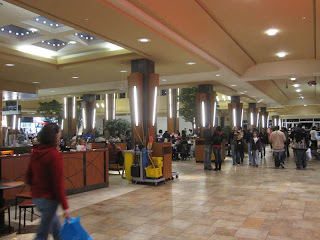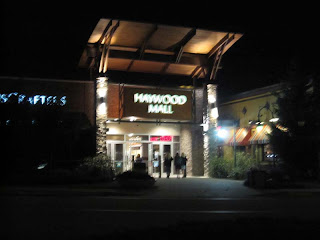While Haywood was very much responsible for the death of McAlister Square and Greenville Malls, the fact was that both of those malls were very lacking in very important areas. Greenville Mall was too far from downtown and was not laid out correctly. It had a poor choice of anchors that proved unstable and unsuitable, and its strange placement on a narrow strip of land made it very one-sided like a strip mall. McAlister Square was just too plain and too old in an area that was likewise trapped in the 60's. Haywood, too, was a pretty basic two level mall, but two level malls have proven to be a rare commodity in the Palmetto State and its big expansion created unlimited possibilities. Also, this mall seems to have everything: sit down restaurants (Panera Bread and Ruby Tuesday), the only Borders Express I have seen, pretty much every mid-market trendy clothing store and a very attractive interior design that seems to have turned out to remain pretty contemporary for a mall built in 1980.
The original part of the mall has two very oddly located escalators. They seem to drop down off to the side away from center court, and they do so singularly on different sides. Cumberland Mall in Atlanta had this set-up prior to the 2007 renovation.
The food court comes off the side of the original mall. Like most malls of that vintage, it was added on as an addition and pops up like an afterthought. It is close to Sears.
Haywood Mall forms an odd-shaped L, but it brought some personality to what started out as a painfully basic mall. The design of Belk, though, is rather strange as if it was always designed for expansion.
On the outside, though, Haywood Mall shows its real age a bit. The Macy's, which opened as Rich's, is a plain brick rectangle. The Belk is quite interesting and quite retro, but it screams disco era. Nevertheless, its uniqueness is unparalleled and needs to remain. It opened originally as Belk Simpson. JCPenney in design is identical to the store at Georgia Square Mall, also built in 1980, with its plain brick appearance accented by lights around the entry area. Sears features a very outlandish and gaudy Logan's Run-style entry. Dillards, added in 1995, is cookie-cutter 90's Dillard's design. It shoudl be noted that the Dillard's was not new to the market. It replaced the older Dillard's at McAlister Square that started out as Ivey's. A parking deck was also constructed in front of JCPenney.
Macy's, formerly Rich's, comes directly off of the center court. Belk faces the Macy's, but actually has a wing attached to it.
Belk's original mall entrance, formerly Belk Simpson. The size of the logo and space for the additional "Simpson" seems fairly obvious here. A Borders Express (not pictured) is to the left of the entrance.
Sears...tiled, basic and bland as usual in this mall. I sure wish Sears would not make every mall entrance identical with that ugly tile.
JCPenney's mall entrance here features the diagonal wood facade behind the sign. It is located on the north end of the original mall.
Haywood Mall's success can mostly be attributed to very aggressive marketing, a forward-thinking two level design and just plain great choices in anchors. It is actually not in the best location for a mall in the city. Greenville Mall was actually the best located mall with high visibility and a location easily accessable from I-85. Haywood Mall is off of I-385 closer into the city in what seems like a less prime retail location, but the lack of land for Greenville Mall to expand hampered its progress in comparison the plentiful land and blossoming strip development that sprouted on Haywood Road just south of the exit. It can be said that a mall, no matter how successful it seems at the time, will fail if it does not attract or maintain the surrounding strip development. While Haywood shared the prime retail corridor with Greenville Mall, the two were close enough that the strip development formed an L in conjunction with Woodruff Road (SC 146). Nevertheless, Haywood Road is not even a marked state highway for even greater curiosity, though it is a state-maintained secondary road (South Carolina maintains most of their roads under state jurisdiction). Greenville Mall was on SC 146. Perhaps those fortunes would have been reversed if Greenville Mall had been better planned.
Instead of side window skylights, the newer Dillard's wing is very 90's with its vaulted skylights down the center.
In this court here, the center opening is round with a pointed dome skylight overhead. Dillard's is straight ahead and a second Belk mall entrance is to the right.
Everything has a point, including this round dome skylight overlooking the circular overlook in the last photo.
Off of the same said court, Belk Simpson comes into view. Panera Bread is to the left on the upper level.
Dillard's mall entrance also features a circular area with dual escalators and an outside entrance corridor off to the side.
Of course, the spirit of competition proves to not always go as predicted. Sometimes the oldest malls emerge the winner, and sometimes the malls nobody would expect become dominant. It was strange enough how this mall opened with a Rich's. Rich's was a standard in Atlanta and well-known, but its expansion into South Carolina and Alabama in the 70's and 80's were a bit odd and a strain on the storied store. Rich's only opened at two malls in South Carolina, and today those are likewise the only Macy's locations in the state. Belk, however, seems to be dominant at most major malls in South Carolina...almost by default. The fact that it is the best looking and most fun mall is undeniable as well. The wood-trimmed ceiling and well-coordinated paint and fixtures give the mall a very rich, elegant appearance. Though it is stripped today of fountains and planters, I am sure those were likely just as nice back in the 80's. The exterior mall entrance signs are also quite showy with significant mountain chalet aspects. I guess the "wood" in the name Haywood must have been some of the logic in doing that.
JCPenney's mall entrance, which is identical to the one at Georgia Square Mall, though it seems the lights have been removed around the frame of the entrance. No other malls in Greenville had a JCPenney.
Belk Simpson at the mall is a retro goody. I thought this picture did not come out, but it passes. Maybe one day I'll get a good daytime shot.
I was unable to get the Sears sign photographed (boring modern one), but I got a pic of this wild entrance treatment. What drug was the person taking that designed that that made them think this looked good?
Macy's, formerly Rich's. This picture did not turn out very well, but it pretty much sums it up. It is the most bunker-like of all the anchors.
In all, Greenville has proved to be quite a hot city. While not a very large city, it graces the center of a large mid-Atlantic style metroplex that stretches continuously from Anderson to Spartanburg, and this mall is at the core of it. Greenville's core is trendy, upscale and unique with a large waterfall forming a distinctive park in the center of the city. Overall, though I was actually quite surprised to see how suburbanized this whole area was. It was quite amazing following the continuous succession of strip malls, subdivisions and restaurants along US 123 leading into the city. When considering that, it is understandable that the market is a bit tight there. The other malls had to compete with both Anderson Mall and Westgate Mall. Haywood does as well, but its dominance is not likely to wane any time soon. While my camera did not cooperate for every angle of the mall, these photos show most of the highlights of a substantial mall. I hope my second South Carolina mall entry does it justice, because I was pleasantly surprised by it. South Carolina deserves more malls like this one.
This shot turned out to be a blurry mess, but the mall entrances are quite elaborate. Ruby Tuesday is just inside the door there, and this is not as fancy as the entrance at the food court. I imagine the original entrance was far more simple.
My sole shot from the lower level. The wooden floors in the center were a nice touch.
A view from the top floor looking onto the bottom floor.
*Correction on the original post. There are three, not two multilevel malls in South Carolina





















































































